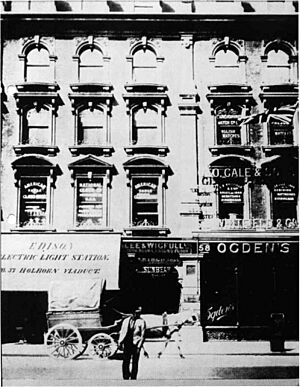Holborn Viaduct power station facts for kids
The Holborn Viaduct power station, also called the Edison Electric Light Station, was a very important place in history. It was the world's first power station that used coal to make electricity for everyone to use. This station was built in central London, England, by Thomas Edison's company, the Edison Electric Light Company.
The power station started working on January 12, 1882. This was just three years after Edison invented the light bulb with a carbon filament. The station burned coal to power a steam engine. This engine then ran a huge generator that weighed about 27 tonnes (that's like 27 small cars!). This generator made direct current (DC) electricity at 110 volts.
At first, the station lit up 968 bright light bulbs for street lighting. These lights stretched from Holborn Circus to St. Martin's Le Grand. Later, the station powered even more lights, up to 3,000! It also provided electricity for homes nearby. However, the station lost a lot of money. It closed in September 1886, and the streetlights went back to using gas.
Just a few months after Holborn Viaduct opened, Edison started another coal-fired power station. This one was in the United States, called the Pearl Street Station in New York City.
How It Started
Before Edison's station, the City of London Corporation tried electric lights in 1878. They put up 16 electric arc lamps on the viaduct. But this experiment only lasted six months, and they switched back to gas lights. Around the same time, the Victoria Embankment also used electric lamps.
The Holborn Viaduct project wasn't the very first public electricity supply. Two months earlier, a small town called Godalming in Surrey got electricity from a water wheel. This was the world's first public electricity supply. However, it was much smaller. It had a 10-horsepower generator that powered only 4 arc lamps and 27 light bulbs.
Building the Station
At the time, there were no laws that allowed companies to dig up streets to lay underground cables. Only gas companies had that right. But Edison's friend, Edward Hibberd Johnson, found a clever solution. He discovered that the Holborn Viaduct had special underground tunnels, called culverts. These culverts were perfect for laying the electrical cables without digging up the streets.
The main machine that made electricity was called the 'Jumbo' generator. It was built in America and named after a very famous circus elephant owned by P.T. Barnum. A special Porter-Allen steam engine, made by Babcock & Wilcox, powered this generator.
Why It Closed
The Holborn Viaduct power station was built on land owned by the Crown (the government). This meant it couldn't be made bigger. Also, as mentioned, it was losing a lot of money each year. Because of these problems, the station closed in September 1886. All the electric streetlights were then changed back to gas lights. The building where the power station was located was later destroyed during the Blitz in World War II. Today, a large building called 60 Holborn Viaduct stands on the site.
See also
- Electric Lighting Act 1882
- Deptford Power Station – UK's first major public power station


